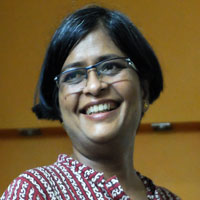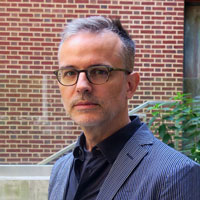
Resilience in Design Pedagogy:
In Conversation with David L. Hays
Smita Dalvi
Tekton
Volume 2, Issue 2, September 2015
pp. 76 – 93
 David L. Hays is Associate Head of the Department of Landscape Architecture at the University of Illinois at Urbana – Champaign, founding principal of Analog Media Lab, and co-editor (with Jonathan D. Solomon, School of the Art Institute of Chicago) of Forty-Five, a journal of outside research (http://forty-five.com). Trained in architecture and history of art, his scholarly research explores contemporary landscape theory and practice, the history of garden and landscape design in early modern Europe, interfaces between architecture and landscape, and pedagogies of history and design.
David L. Hays is Associate Head of the Department of Landscape Architecture at the University of Illinois at Urbana – Champaign, founding principal of Analog Media Lab, and co-editor (with Jonathan D. Solomon, School of the Art Institute of Chicago) of Forty-Five, a journal of outside research (http://forty-five.com). Trained in architecture and history of art, his scholarly research explores contemporary landscape theory and practice, the history of garden and landscape design in early modern Europe, interfaces between architecture and landscape, and pedagogies of history and design.
Hays is the editor of Landscape within Architecture (2004) and (Non-)Essential Knowledge for (New) Architecture (2013), both by 306090/Princeton Architectural Press. His essays have appeared in a wide range of academic and professional journals—including Harvard Design Magazine, PLOT (City College of New York), Eighteenth-Century Studies, The Senses and Society (Oxford), Junk Jet (Amsterdam/Stuttgart), Matéricos Perifericos (Rosario, Argentina), and Fengjinyuanlin and Landscape Architecture China (Beijing) – and as chapters in numerous books.
As a designer, Hays explores the production of environmentally responsive objects using low-cost, low-tech materials. With particular interests in dynamic systems, environmental phenomena, and craft, his process crosses lateral thinking and intuition with grounded experiment.
Design pedagogy today struggles between a desire of jettisoning the crutches of predictable, xed modes and responding to a changed world where not only do we look at the disciplines and their inter-relations differently but also where new technologies of production of design is impacting the way we think about them. In this free-ranging conversation with David L. Hays, we explore issues of disciplinarity, innovation, open-ended and experiential modes of design thinking, role of history and theory and much more that excites and informs how we teach design. We acknowledge the contribution of Prof. Amita Sinha in helping to frame some of the topics of this conversation.
DALVI
In your introductory essay for ‘(Non-) Essential Knowledge for (New) Architecture’, you suggest that design innovation is no longer a preserve of the experts; it can come from anywhere and is likely to adopt lateral thinking and lateral methods. Can you elaborate?
HAYS
To innovate is to change something through new ideas or approaches. But how does innovation come about, and who are the innovators? Experts have authoritative knowledge. They know the conventions of their respective disciplines, whether practical or theoretical. Expertise makes evident both what is known and the limits of what is known, the terrae cognitae and the terrae incognitae, and that understanding has great value for innovation. However, new ideas and approaches are not located inside a disciplinary body of knowledge. Innovation requires something else, something from beyond what is known.
As I noted in (Non-)Essential Knowledge for (New) Architecture, disciplinary knowledge is typically conceived as if a coherent body defined by two lines: one central – the sequential process through which core knowledge is obtained, leading to mastery – and the other marginal – the “front line”, where limits are tested and new knowledge is formed. In that way of thinking, disciplines are corporate entities, and disciplinarity is a territorial enterprise. The two defining lines guarantee both productivity (occupying and elaborating) and integrity (circumscribing and defending). To be recognized within that framework, new knowledge must be contiguous with normative understanding – meaning, it must be proximate to the “front” line. If it is too far beyond that line, its relevance will not be discerned.

